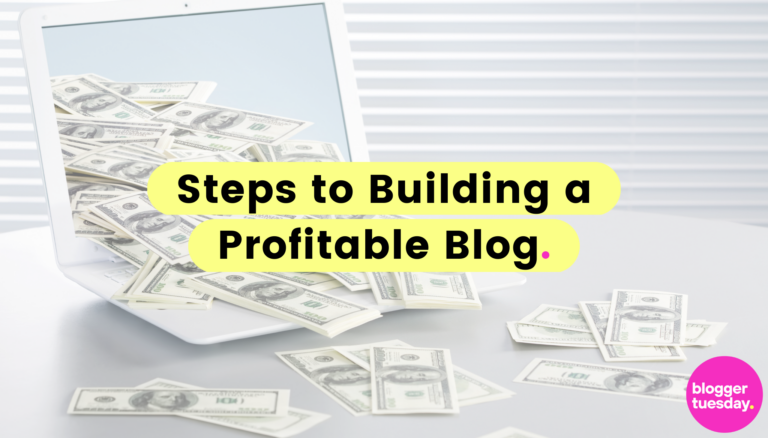Blogging has become a popular part of internet culture, and it’s a great place to write about your life, interests, and whatever topic that you’re really feeling like at the time. For a long time, that’s all blogging really was, but it has since grown – and now it’s possible that your blog can help you make money. Building a profitable blog isn’t something that only certain people can do, either, it’s for anyone who is willing to put in the time and effort.
It’s important that when you’re starting out, you’re realistic about it. You’re not going to bring in millions of dollars on your first day, but generating an income is in fact possible with the right person behind the blog. It’s about knowing how to approach it, and how to build on it to make it profitable in the end. No blog can be profitable on the first day.
Choosing your angle
Before you can start making money from your blog, you need to first get traffic there. If people are going to come to your blog, then you need an angle or a niche, something that interests people. While it might seem like a good idea to have your blog based on nearly everything, that’s generally not the best decision. You don’t want people showing up for just one blog and then leaving, you want consistency with your audience, and choosing a niche is the best way to go about that.
The niche you pick will help you decide on the name of your blog too, which will make it easier for those with an interest in what you’re posting to find you. Having words related to your blog in the name of it will make it much easier for your viewers to remember you, and you have more chance of audience members finding you by chance – even if they’re not searching directly for one of your posts.
Picking a blog name can be tricky, and you have to be careful with it – because it’s not something you’re going to want to change every day. Once you start to grow, changing the name of your blog can be harmful, so make sure you spend some time picking the right name.
Remember, that not every niche you pick is going to be successful. Simply picking an angle and running with it isn’t always going to work out. You want a niche that people are searching for, and that people are going to frequently click on for information – it won’t help to go with something that’s unheard of.
Putting yourself online
Once you know what you want to post about, then you can think about actually getting started. If you’re new to blogging, you need to get used to this unfamiliar territory, and it can be quite difficult to get into. Writing and putting your passion into words isn’t something that comes naturally to everyone, and it might take some practice.
To get your blog online, you need a website – and there are a number of ways you can go about this. Whether you’re going to use a platform that’s great for blogging, like Squarespace, or WordPress. These platforms are great for beginners, as while they might take a little learning to get set up, that learning curve is low. It’s not as complex as manually setting up your own website from scratch, and it has everything you need to run an optimized blog. Every blogger has their own preferences, so it might be worth checking around to see who uses what and why.
Settling on a design
For your blog to be profitable, it has to be appealing, and to do that you need to have great design. There are so many things to think about when it comes to the design of your blog, from the colors to the layout, to the font that you’re using on your posts and more. There’s a lot of planning that goes into the design, and you need to make sure it’s consistent with the niche that you’re picking, and the personality that you’re going to put into your blog. You don’t want viewers to click on your blog to be met with plain black-and-white designs, that lack personality.
Having appealing colors is important, but as your blog is going to be mainly about the writing, you should put a lot of thought into the font that you pick. Having a font that’s difficult to read is something you should avoid as much as possible. Cursive looks great, but some fonts aren’t ideal if you’re aiming to have your blog easily readable by a broader group of viewers.
Then there’s the case of your formatting. You need everything to be laid out in a way that’s easy for others to understand, and it might actually be helpful to take inspiration from other blogs. You’ll notice that there’s a popular format among other blogs, and there’s a reason for this. Having a similar layout makes it easy for newcomers to figure out how you’ve got your blog laid out.
Create your landing pages
While the main thing you’re going to think about when creating your blogs is the blog posts themselves, there is of course more to it than that. When your viewers enter your blog, they might want to learn more about you, and most bloggers have a few pages that offer more details. These pages are important, because not only do they add more personality to your blog, but you need a landing page that keeps viewers around. Make it interesting, but also don’t try to offer more than the readers are there to see.
It’s also a great place to talk about what makes your blog a credible place and offer up some information as to why the blogs you’re posting might be valuable reads to your viewers. What experience do you have? How successful have you been with blogging? It doesn’t have to be full-on bragging, but having these things on display isn’t just for your viewers, it helps with partners and marketers too.
Optimizing your blog
The sooner you learn about optimization for your blog, the better. SEO is a major part of finding success for any online business, blogs included. Search Engine Optimization is the process of making your blog more recognizable and favorable to search engines. There are multiple factors that are taken into account when optimizing your blog, such as the format as mentioned before, but also the content that you’re posting. You might have the idea that the key to gaining popularity in a blog is through consistent posts, and while you would be partially right – those posts also need to be filled with engaging content.
The ratings that the pages on your blog are given are based on their content of them, and the keywords that you’re using. Ideally, when writing about a topic, you want to use relevant keywords that have a lot of traffic. Learning to integrate keywords into your blog posts can be challenging at first, but once you’re used to it, it can be easily done with each new post.
Start brainstorming
The best way to go about taking on a big task is to get planning. When it comes to your blog, there are so many things you can plan, and the more planning you do – the better. You need to be able to post consistently if you want to maintain readership, so there’s no such thing as too much planning. Think about what kind of posts you want to make, think about how you can make them more interesting for people to read – think about how you can work popular keywords into them.
You don’t have to blog about every thought that comes to mind, but taking the time to brainstorm some ideas can be very positive to the growth of your blog. What kinds of things excite you when thinking about your niche? What challenges and questions are there that typically surround that niche? How can you relate your niche to your readers? These questions are important to ask, and from these, you can often generate countless blog titles and topics.
Get writing
Now that you’ve got everything down on paper, you should have plenty of ideas to pick from – it’s just a matter of picking your debut topic. It doesn’t have to be incredibly long, and it’s important that you’re not trying to go too far with how much you write that you start waffling about the topic. Keep it interesting and stop when you’ve written too much.
Monetize it
Everything is set up, and it’s time to look into how you can start earning from your posts. There are a number of ways you can monetize your blog, and it really comes down to the preference of the blog owner. You could make money through premium subscription content, you could use your blog to sell a product, or you could use advertisements to earn money through clicks. The key to earning a profit, however, is having a high-quality blog.


